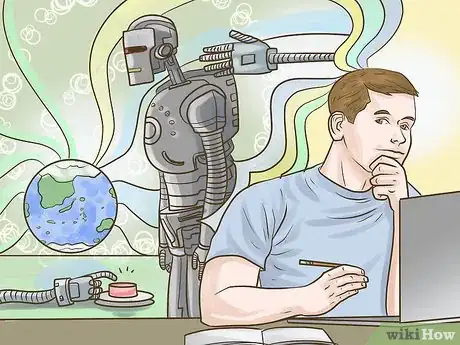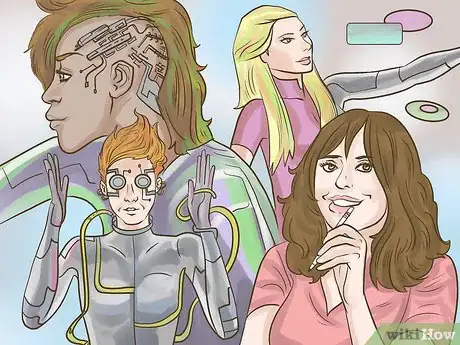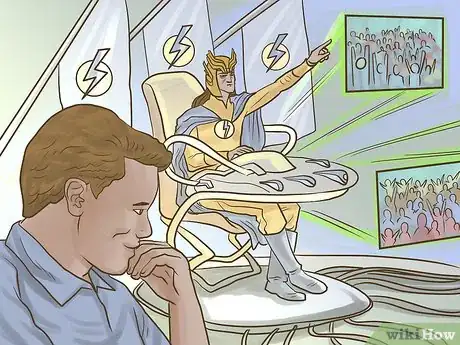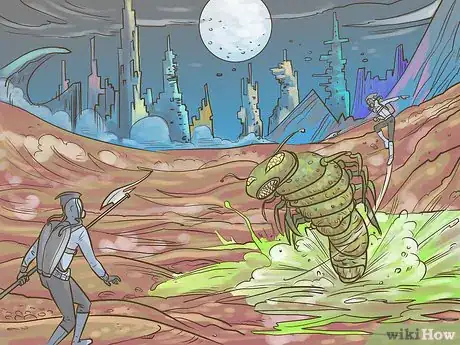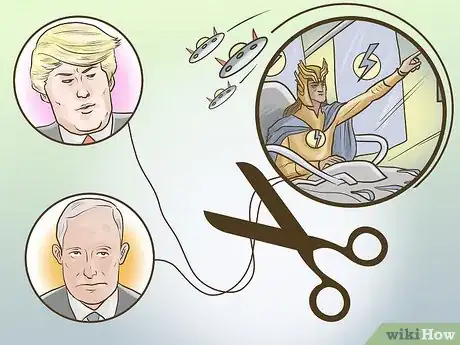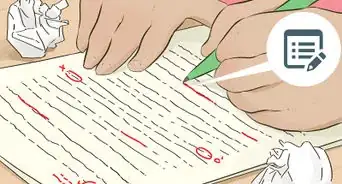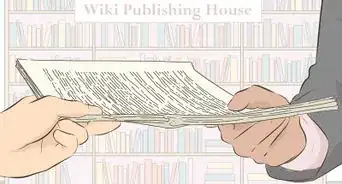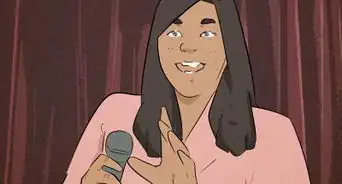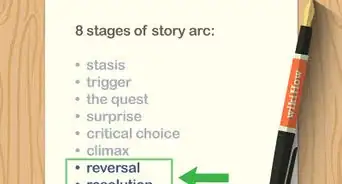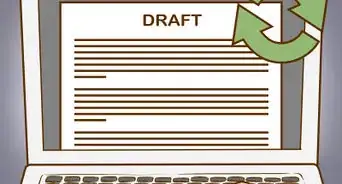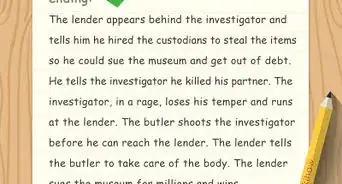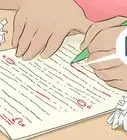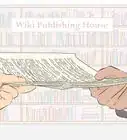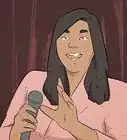X
This article was co-authored by Christopher Taylor, PhD. Christopher Taylor is an Adjunct Assistant Professor of English at Austin Community College in Texas. He received his PhD in English Literature and Medieval Studies from the University of Texas at Austin in 2014.
This article has been viewed 48,062 times.
Futuristic fiction has all the basic elements of a story, from perspective to plot to characters. What sets it apart is its distinctive setting. If you'd like to write a story set in the future, you have start by imagining a future world. Find out how to spark inspiration, develop a compelling and cohesive reality, and ensure that your narrative will continue to excite future readers.
Steps
Method 1
Method 1 of 3:
Getting Started
-
1Read widely in the genre. If you want writing inspiration, start by reading. Go to the library or bookstore to get futuristic, sci-fi, speculative, and/or dystopian novels and short stories.
- There is a huge variety to choose from. Try everything from classics like Aldous Huxley's Brave New World to recent favorites like Suzanne Collins's The Hunger Games.
- If you're looking for critically acclaimed futuristic fiction, search for books and short stories that have won the genre's top honors: The Hugo[1] and Nebula Awards.[2]
- As you read, take notes about the things you admire about a particular text since you may be able to incorporate similar techniques into your own work.
- For instance, you may like how a particular story is told from the perspective of two different characters or how another introduces its setting through a chase scene.
-
2Do your research. The best way to generate ideas about what the future in your story should look like is to do research about what things are like today. Look for trends in politics, economics, science, and pop culture. Oftentimes, the best futuristic fiction offers worlds that are possible projections of our future based on the potential consequences of current scientific, environmental, and political trends.[3]
- Since you're writing about the future, focus on what seems cutting edge. Look into recent developments in science, space programs, and technology. Consider what is happening to Earth's environment or what scientists project will happen in our future solar system, galaxy, or universe.
- You can also research current social and political trends and conflicts, such as struggles for women's empowerment, economic inequality, or rising tensions among world superpowers.
- You can narrow the scope of your research by focusing on the trends that interest you most or by deciding what topic it is that you would like to offer some commentary on.
Advertisement -
3Pursue a scientific theory or idea. If you're particularly taken with a specific scientific development or theory, why not use it as your inspiration? Think about a world in which the theory has become reality or a promising scientific development had been fully realized.[4]
- For instance, if you're interested in physicists’ Many Worlds theory, write a story in which you make that abstract theory come to life by depicting a multi-dimensional universe.
- If you're keen on robotics, you might want to imagine what Artificial Intelligence will look like in the future when we have completely automated lives.
Advertisement
Method 2
Method 2 of 3:
Developing Your Future World
-
1Decide your time period and location. As a starting point, you should figure out where and when you would like your story to take place. It could be on Earth or on another planet altogether. It could be tens, hundreds, thousands or maybe even millions of years in the future.
- Remember, not everyone has to live on a spaceship or consort with aliens for your story to be futuristic.
- Make your decisions based on what kind of story you would like to tell about the future. If you're projecting a time when humans have evolved to be bodiless, you might want to set it further in the future than if you still include humans who look much like they do today. Have a reason why for the place and time you choose for your story.
-
2Develop your future world. To write a credible futuristic story, you have to start by creating your future world. In fact, the story itself should arise from your world. Now that you have the basic wheres and whens down, it's time to start figuring out the details. The more detailed your world is, the more people will believe in it as they are reading.
- Start by considering what makes your future world different from today and what things are the same. Then, delve into the details of how your future's technology, society, politics, and environment are structured.
- Take notes about each of these categories. Not all of them may come up in your story, but it will help you to fully imagine the world you're introducing to readers.
- If you know lots of particulars about your world, put in concrete details, such as architecture and landscapes, that will make your setting seem more real to readers.
- Keep in mind that your decisions about how to characterize a future world should be driven by what sort of commentary you want to offer about the present. If you think Artificial Intelligence is a positive thing, for example, then you can start by imagining a utopian world in which the human race has been replaced by AI.
-
3Consider what technology will be available. Decide if your future will be more or less advanced technologically than today. Imagine what technological developments may have taken place between now and then. Remember to consider not only big-picture changes, like the ability to time travel, but also what kinds of tech people will be using in their everyday lives, such as modes of transportation or communication.[5]
-
4Characterize your future society. Now, consider what the inhabitants of your future world will be like. What will they look like? What species will they be? Map out the norms you imagine for their general family structures, occupations, and lifestyles.[6]
- Seemingly mundane details, such as what people eat and drink or what their houses are like, will go a long way towards establishing a compelling future world.
-
5Think about politics. Besides ruminating on your future's social norms, you should take time to imagine what its political system looks like. How are territories recognized or divided in your world? Do nations or countries still exist or is there a significantly different geopolitical arrangement? What sort of government(s) exist in your world, and who holds political power?[7]
-
6Describe the environment. What does the natural world look like in your future? Think about its weather or climate and landscape as well as its flora and fauna.
- For example, if you're setting your story on a future Earth, you might consider which species have evolved and which ones have gone extinct. You could make predictions about how the climate has altered and which land masses are now covered in water.
-
7Make sure your vision is cohesive. There should be an internal logic to how your world is imagined. When your audience is reading the story, all the concrete details included in it should make sense to them and check out with one another.[8]
- For instance, if people have evolved to communicate telepathically, they probably wouldn't still be using mobile phones.
Advertisement
Method 3
Method 3 of 3:
Making Your Future Stand the Test of Time
-
1Don't make the connections to the present too explicit. While the present should serve as a source of inspiration for your futuristic story, you don't want to date it by making it speak too directly to current events. If you do, your future will get stale pretty quickly. Offer commentary without limiting it to a specific historical moment.[9]
- For instance, if the characters in your story exactly mirror specific historical figures, such as Presidents Donald Trump and Vladimir Putin, then the narrative and its commentary will not extend much past the present day.
-
2Be careful how you write about technology. The pace of technological innovation is so rapid that it's difficult to keep up. Lots of tech is obsolete within a few years of its development. Hence, if you describe the future technology in your book in too much detail, especially if your projections are based on where we’re at today, it's bound to feel retro pretty quickly. Instead, focus on describing what the technology does rather than on the specifics of how it looks or works.[10]
- You don't want to describe screens and wires when those elements may become a thing of the past.
- Instead, leave some gaps as to the details to let your readers’ imaginations fill them in accordingly.
-
3Avoid potential historical blunders. If your story projects an event, society, or character that was supposed to happen in the distant future but has already taken place in the reader's present, the text will feel dated. Hence, it's a good idea to resist including “first,” “lasts,” and “onlys” in your futuristic writing.[11]
- For example, if your story is about the first humans to land on Mars, that's a reality that could happen sooner than you think. If one of your characters is the first female president of the US and you set the story a millennium from today, your premise will seem somewhat obsolete when there is a woman president.
Advertisement
Community Q&A
-
QuestionIs there anything that NASA is working on that is going to happen in the 2020s, specifically 2024?
 Community AnswerYes, that's NASA's projected completion date of their Deep Space Gateway lunar platform, which will act as an outpost for astronauts.
Community AnswerYes, that's NASA's projected completion date of their Deep Space Gateway lunar platform, which will act as an outpost for astronauts. -
QuestionWill sex be the most dominant option for procreation?
 Community AnswerNot necessarily; as science progresses, there will be advances in artificial insemination and lab-fertilized eggs, which could facilitate cloning and other options that exclude the act of sexual intercourse from procreation. There may also be ways to "download" one's memories and consciousness into one or more artificial beings, thus eliminating biological functions such as eating or producing waste. Depending on how far into the future your story takes place and the social climate of your setting, the act of sex could even be considered barbaric and crude.
Community AnswerNot necessarily; as science progresses, there will be advances in artificial insemination and lab-fertilized eggs, which could facilitate cloning and other options that exclude the act of sexual intercourse from procreation. There may also be ways to "download" one's memories and consciousness into one or more artificial beings, thus eliminating biological functions such as eating or producing waste. Depending on how far into the future your story takes place and the social climate of your setting, the act of sex could even be considered barbaric and crude.
Advertisement
References
- ↑ http://www.thehugoawards.org/hugo-history/
- ↑ http://nebulas.sfwa.org/search-awards/
- ↑ https://deescribewriting.wordpress.com/2010/10/12/tuesday-writing-tip-how-to-create-a-futuristic-world/
- ↑ https://deescribewriting.wordpress.com/2010/10/12/tuesday-writing-tip-how-to-create-a-futuristic-world/
- ↑ http://www.publishingcrawl.com/2012/06/26/writing-futuristic-fiction-in-what-feels-like-a-science-fiction-world/
- ↑ http://www.publishingcrawl.com/2012/06/26/writing-futuristic-fiction-in-what-feels-like-a-science-fiction-world/
- ↑ http://www.publishingcrawl.com/2012/06/26/writing-futuristic-fiction-in-what-feels-like-a-science-fiction-world/
- ↑ https://deescribewriting.wordpress.com/2010/10/12/tuesday-writing-tip-how-to-create-a-futuristic-world/
- ↑ http://www.writermag.com/2015/10/13/control-future-tips-writing-sci-fi/
About This Article
Advertisement


